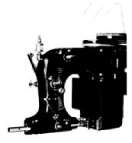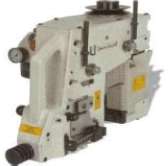Bag History

No.1 Bag Making Machine of 1881
Bag Making and Closing Machines
When Jasper W. Corey vowed to build the best bag machine, he was ultimately laying down the foundation for Union Special Corporation. Together with Lorenz Muther and Russel G. Woodward the work on a new bag making machine began in the early spring of 1880 and was completed the same year. Known as the Union Bag Machine, it was placed in a bag factory in Chicago for a practical demonstration.

William Stanley North
When compared to the competitive machines, it could produce more bags in the same time with greater ease, fewer repairs and less expense. The major advantage was the production of a 'double-locked stitch' by use of a straight needle. The Union Bag Machine was the most rapid chainstitch on the market - operating at twice the speed of existing machines.
The bag factory testing the machine was so enthusiastic that they immediately ordered twelve more. Corey in the meantime withdrew from the enterprise to pursue the study of medicine. Handicapped by a limited number of tools, Woodward and Muther, out of desperation, appealed to friends for financial assistance.

They attracted the attention of William Stanley North, a man of extensive business experience, dynamic force and integrity. North, convinced that the undertaking was sound and could be made successful by applying good business principles, organized the Union Bag Machine Company in 1881. He was elected the company's first president.

The Union Special Building in Chicago
In order to prove that the machine would reduce production costs, the company started its own bag factory where machines could be seen in operation under actual factory conditions. In a short time, bag manufacturers realized the advantages of the machine and the company was able to discontinue manufacturing bags, concentrating its efforts on sewing machine development and production.
The Union Bag Machine was accepted as the best and fastest on the market. Many were sold to the principal bag manufacturers throughout the country. The success of the Union Bag Company was assured. William Stanley North, as President, knew how to choose the right men for the right jobs - and his ideas were years ahead of the moment, planning for the future of the thriving young company. Research in design, materials and methods was an integral part of the company's operations from the start.

20 years after a very successful start-up in Chicago - in 1901 - a new production facility was founded in Stuttgart / Germany under the name 'Union Special Maschinenfabrik GmbH'. Fritz Wever - who in 1898 already took over the distributorship of Union Special for Germany - served as Managing Director and started production with 58 employees in 1901.

No.1 Bag Making Machine of the Stuttgart production
A very close cooperation between Chicago and Stuttgart was the basis for the successful development of attachments and many new types for various seams. Within a few years the GmbH had 150 employees and branches for sales and service in many other towns in Germany.

Bag Sewing Machine ‘Antaus’
A very tight and flexible double chain stitch could be produced on all kind of material. Later-on Nr.3 got type No. G80000.

Bag Sewing Machine ‘Heracles’
A wide range of machines was produced - such as two-needle machine G1900C, Cylinder coverseam machine 11800C, interlock machine G76300H and many others producing various kinds of seams on bags and other articles of heavy material.
Union Special started with machines for producing bags and within a few years these machines were well known all over the world and accepted as the best for these operations. Therefore it was finally a small and very promising step to develop and produce also machines for closing filled bags - machines with another design, fixed on a column or on a similar construction or suspended by cable from tandem pulleys and counterbalanced by a suitable weight.

Bag Closing Head Style 14500

Style 20300C – economy machine with swinging head support; for bags weighing over 50 pounds.

The famous ‘black’ sewing head 80600
Suspended with top balancer or counterweighted or fitted to any kind of column, style 80600E (401 stitch) was the mostly wanted machine head.

Style 21800J with head 14500 (built 1936)
Union Special got the market leader in bag making and bag closing machines and developed a vide range of basic styles and attachments.
App. 30 years ago the so-called 'Baby' was born - style 2100, which was succeeded by style 2200 with a new motor a few years later. This machine can sew with one or two threads and is equipped with an upper feed which guarantees an exact feeding on all kind of materials.

Styles 2200

Styles 2000
Style 2200 is also available as battery operated, portable bag closing machine.

Styles 3000
Styles 2200, 2000 and 3000 can be delivered with motors for 50 - 60 Hz and different voltage.


Bag Closing Unit with Sewing Head 80800, Column, Belt Conveyor, Bag Feed-in-Device and Spreader
Style 39500TYA as a single needle, plain feed, three thread overedging machine for a turned-up seam is especially used for making mesh bags for fruits, onions or potatoes.

Styles 39500TYA, 56100T and 81300A

80200AA the succeeding Antaus, 81200A as Heracles are the most sold machines for producing heavy bags. Furthermore are available two needle machines with adjustable hemmer for heavy weight bags or geo-textiles.
Beside of the basic 81200A as overseaming machine also styles 81500 with a width of seam up to 19 mm and equipped with upper feed and alternating presser foot are recommendable especially for heavy jute bags.

80700C with pedestal
Series 80700C and 80700CD - one and two needle machines - are new developments for the production of container bags. These top feed machines are a must for all producers of such kind of bags.

Types BC100
Styles BC100 can be offered in the standard version with continuously driven nibbler knives, with thread chain pusher device or in the automatic version with automatically by feeler controlled proximity switch for start-stop and an automatic thread chain cutter by electro-pneumatically operated scissors.

Types BM100 Types BML100
These new machines are available as one or two needle machines and with a newly developed hot cutting device.
